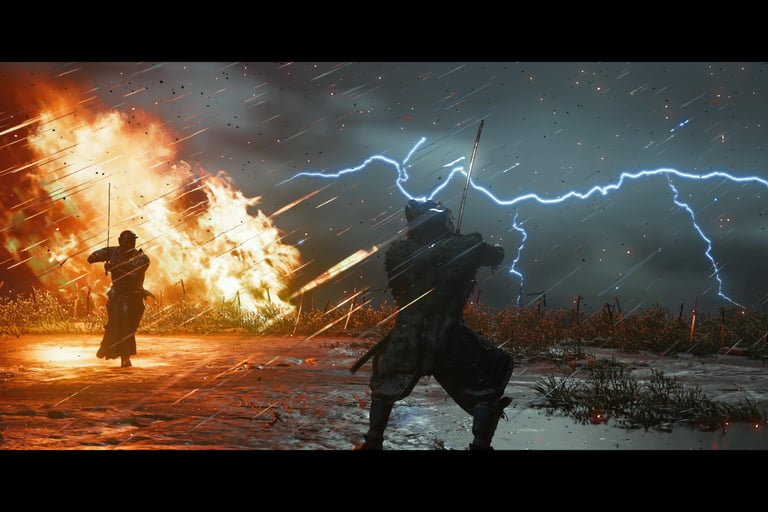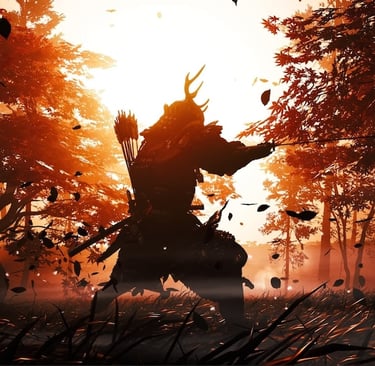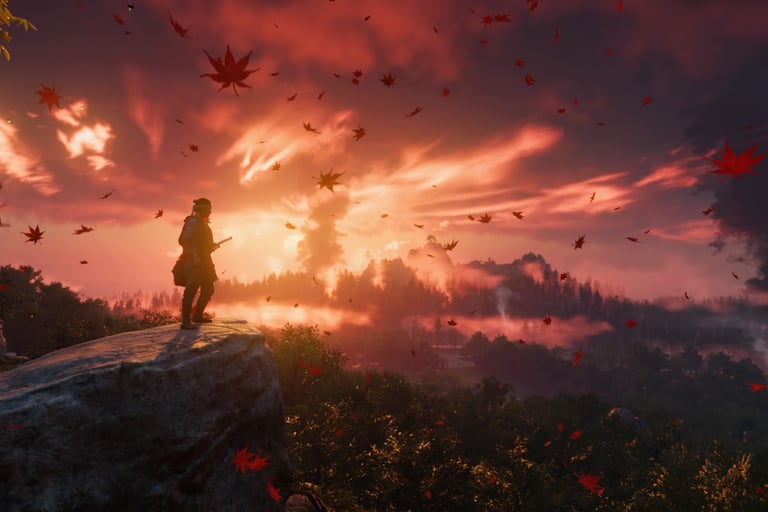Ghost of Tsushima Review
Samurai Meets Ubisoft Design
REVIEWS
MattGhostie
11/18/20254 min read
A Samurai Epic Wrapped in an Open World Formula
Ghost of Tsushima from Sucker Punch Productions is an ambitious open world samurai adventure set during the Mongol invasion of 1274. You play as Jin Sakai, one of the last surviving samurai on Tsushima Island who is forced to evolve beyond the traditional warrior code he was raised with in order to save his home.
On the surface, the game follows a familiar open world structure. You liberate outposts, expand the map, complete character missions, and chip away at territory lost to the invaders. What elevates Ghost of Tsushima is the amount of style, sincerity, and cinematic flair poured into every element. Instead of reinventing the genre, the game aims to be the most polished and emotionally resonant version of a classic open world formula.
Jin Sakai: Torn Between Honor and Survival
Jin’s story is a gradual breakdown of the identity he once believed was unshakable. Throughout the game, he faces situations that push against the teachings of the samurai: battles where stealth saves lives but breaks tradition, allies who discard honor for effectiveness, and enemies who manipulate the samurai code to extremely brutal effect.
While Ghost of Tsushima does not give players branching moral choices, the narrative still carries weight. The emotional impact comes from Jin’s internal conflict rather than from branching dialogue or alternate endings. It is understandable why some players wished the game systems reflected its moral themes more dynamically, but the story still succeeds because Jin’s journey is written with intention. Personally, I would've liked Sucker Punch to bring back the morality system from their previous Infamous games so players could see how embracing the Way of the Ghost or the Samurai effected both Jin and the world, but what we got is still a very well told story.
The supporting cast also brings surprising emotional depth. Masako’s grief, Ishikawa’s guilt, Norio’s crisis of faith, and Yuna’s survival instincts all showcase different consequences of war and force Jin to confront uncomfortable truths. Their missions give Tsushima a distinct level of introspection and help the world feel inhabited rather than like a checklist of NPCs waiting for objectives.
Steel, Stances, and Swordplay
Combat is where Ghost of Tsushima sets itself apart. The stance system allows you to shift into styles designed to counter specific enemy types. Stone stance is effective against swordsmen, Water stance is ideal for shield users, Wind stance disrupts spearmen, and Moon stance crushes heavy brutes.
In practice, switching stances creates a rhythm in battles. You are constantly identifying threats, adapting your approach, and timing your parries or dodges with precision. It rarely feels like button mashing and it never becomes a simplistic hack and slash. Instead, the combat becomes something close to choreography. When everything clicks, you cut through squads of enemies with a level of flow that few action games reach.
Stealth is simple but satisfying. Tools like kunai, smoke bombs, firecrackers, and bows add a versatile layer to encounters. You can thin out patrols before a fight or vanish mid encounter to regain control. The game never forces stealth, but the option is consistently rewarding which ties into the narrative themes quite nicely.
The one on one duels deserve special praise. These fights are cinematic, personal, and stripped of anything unnecessary. There are no tricks or gimmicks. It is just your blade against another warrior’s skill and conviction. These battles function as both gameplay peaks and emotional storytelling moments. Each of the 25 duels were particular highlights for me and served as capstones to an overall amazing combat experience.
A Stunning Island with Familiar Open World Structure
Tsushima Island is one of the most visually striking worlds in modern gaming. Rolling golden fields, red-leaf forests, misty coastlines, and windswept cliffs create an island that feels painterly and alive. Nearly every frame could serve as a desktop wallpaper. The minimalist HUD reinforces immersion and the guiding wind system cleverly replaces waypoints without breaking the tone.
Despite the beauty, the world design sticks to a familiar structure. You clear Mongol camps, climb shrines, follow foxes to Inari altars, and uncover question marks scattered across the map. None of these activities are groundbreaking, but they are executed with incredible polish. If you enjoy open world progression loops, this game is comfortably one of the most rewarding examples.
Tsushima is packed with small, thoughtful touches. Haikus, bamboo strike challenges, hot springs, mythic tales, and environmental clues all reward your exploration. These activities tie into themes of reflection, discipline, mindfulness, and personal growth. The island is not simply a playground; it feels like a character in its own right. This serves in stark contrast to many games where the world feels purpose built for the main character, whereas in Tsushima Jin feels like he is a product of the world he exists in.
A Samurai Journey Worth Taking
Ghost of Tsushima does not revolutionize the open world genre, but it excels because of how intentionally crafted each part is. The narrative is emotionally grounded even without player driven morality. The combat blends style and strategy with exceptional fluidity. The world is breathtaking and consistently immersive.
The magic of Ghost of Tsushima comes from how these systems harmonize. A perfectly timed standoff. A sword duel at sunset. A quiet moment composing a haiku beside a cliff. A ride through a storm with nothing but the wind guiding your direction. The game understands the fantasy of being a lone warrior shaped by the land around him, and it delivers that fantasy with clarity and confidence.
It may not be the most innovative open world game ever made, but it is easily one of the most beautiful, polished, and memorable experiences the genre has produced.







